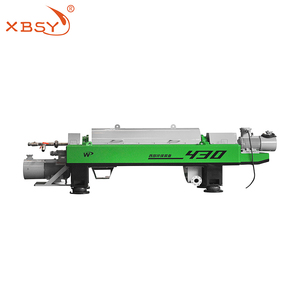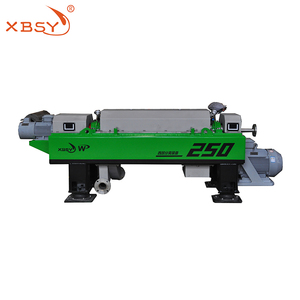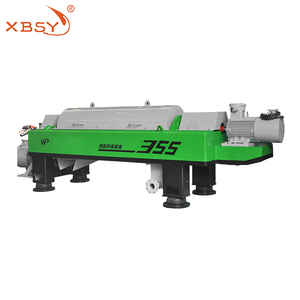
All categories
Featured selections
Trade Assurance
Buyer Central
Help Center
Get the app
Become a supplier

(2782 products available)




















A decanter centrifuge for sludge dewatering is designed to separate solids from liquids in the sludge. There are several different types of sludge dewatering decanter centrifuges.
Conventional Decanter Centrifuge:
The conventional centrifuge is a machine often used to dewater sludge in wastewater treatment facilities. It separates solids from liquid sludge by utilizing a helical screw to accelerate sedimentation and extract the dried sludge. This mechanism helps remove excess water, leaving behind a cake of dehydrated sludge that can be disposed of or further treated. The conventional decanter centrifuge operates based on the density differences between solids and liquids, providing an efficient method for sludge processing
High-Speed Decanter Centrifuge:
A high-speed centrifuge for sludge dewatering is like a conventional one but rotates at a higher speed. This increases the level of specific gravity to separate solids and liquids, giving them a dryer cake and better polymer utilization. However, it requires more energy to run and is also noisier. Some examples include the Roto-Gro Sludge Dewatering Centrifuge and Flottweg Z Belt Filter Centrifuge. The former uses a cross-flow filtration method and a self-cleaning rotary drum filter to separate solid and liquid components and has a maximum throughput of over 400,000 gallons per hour. The latter does not come with any disclosed specifics on them.
Vertical Screw Expelled Centrifuge:
The vertical screw-expelled centrifuge stands vertically instead of horizontally like in other designs. This makes it easier to arrange, and operators can reach every part of the machine when it needs to be maintained or cleaned. The vertical design also lets the machine run at lower speeds than the others. However, the risk of internal wear is greater due to the fact that the settled solids are constantly being pushed out by the screw. This is better used for small or medium-scale treatments.
Combined Collector Centrifuge:
This is a specific type of vertical centrifuge. It possesses a combined feed zone that allows for the input of multiple sources of sludge at once and a conical bowl that provides a larger area for effective separation. The feature of a cone increases the speed of specific gravity for better separation of solids and liquids.
The sludge decanter centrifuge comes in different specifications to fit various industrial applications. Its specifications are determined by factors like the intended application, water content of the material being processed, and capacity requirements.
It is very important to keep the centrifuge well maintained. Some regular checks and preventative maintenance are crucial to ensure the efficiency of the sludge decanter centrifuge and prolong its lifespan.
Sludge dewatering decanter centrifuges are commonly used in industries that generate large volumes of wastewater and solid sludge. Most wastewater treatment facilities worldwide have installed these machines to handle the constant flow of organic matter they treat.
Food and beverage manufacturing is another industry where these centrifuges are helpful. Production lines for dairy, juice, breweries, distilleries, soft drinks, and any other beverages that leave sediment require an effective method of dewatering the residual sludge. The solid material is usually rich in organic matter that can be composted or used as biomass by other industries to generate energy.
Textile manufacturing also generates large amounts of sludge containing fibers that, if not properly treated, can clog landfills. Sludge from the industry is usually rich in cellulose and other biodegradable organic matter. Rather than discarding it as waste, a decanter centrifuge for sludge can help extract a clear liquid that can be reused in the textile process or be treated further for a better-quality effluent to be directed into water bodies.
A common by-product of coal, gypsum or carbon black, can also be treated with a decanter centrifuge to separate the cleaner liquid and ensure the product is marketable and doesn't take up large amounts of space in storage facilities. The solid residue can also be used as fertilizer in agriculture.
Oil and gas industries employ centrifuges to separate solid and liquid sludge that settles at the bottom of storage tanks. The cleaner oil can be reused in the process or sold in the market, and the solid residue can be treated further for landfilling or incineration.
These are just a few examples of sludge dewatering decanter centrifuge applications. Any industry that generates solid sediment from industrial processes—such as paper and pulp, mining, chemical manufacturing, surface treatment processes, and more—can likely benefit from the separation capabilities of centrifuges.
When purchasing a sludge decanter centrifuge, there are several key features to keep in mind in order to ensure optimal performance, efficiency, and reliability. This includes the construction material, conveying system, mechanical seal, and power system, among other aspects.
It is crucial to select a dewatering centrifuge that has a rugged and corrosion-resistant construction material, commonly stainless steel, which provides protection against aggressive and abrasive sludge. Buyers should also ensure that the sludge dewatering decanter centrifuge has a robust and wear-resistant solid-liquid separation element, such as the filter basket, which undergoes frequent mechanical cleaning to prevent clogging and ensure uninterrupted operation. Some examples of these separation elements include spiral screens and mesh filters.
This type of centrifuge may have different conveying systems for solid particles, including a scroll with a central shaft or a separate drive system with a magnetic coupling. These variants may have specific advantages, such as energy efficiency, lower maintenance requirements, or effective solid transport. To ensure proper maintenance and service support, buyers are advised to consider the availability of spare parts for the conveying system they choose.
Opt for a centrifuge equipped with high-quality mechanical seals that reliably prevent any leakage of hazardous or toxic materials into the environment.
The power system of a sludge decanter centrifuge primarily comprises its transmission and motor parts. Buyers should choose models that have efficient and adjustable motors to ensure optimum power utilization and dewatering efficiency.
It is also important to take note of how easy and accessible it is to maintain and service the centrifuge. Features that facilitate maintenance include easy-to-replace components, built-in self-diagnostic systems, and automatic lubrication.
When choosing a centrifuge for sludge separation, it helps to select the one that is compatible with available treatment facilities. For instance, preferred receptacles and wastewater treatment methods for the effluent from the centrifuge should be considered. This can help enhance overall efficiency and streamline the treatment process. It may also be helpful to choose a centrifuge that has advanced control features, such as automatic adjustment of feeding rates, separation factors, and scrolling speeds for different sludge types and operating conditions.
Q1: Does a centrifuge separate all types of solids in a solution?
A1: No, the centrifuge can only separate the solids that can be settled by gravity. Those that require centrifugal force for settlement will be separated by the centrifuge. Normally, fine particles and colloidal solids will need the centrifuge for proper separation.
Q2: Is there a difference between a centrifuge and a decanter centrifuge?
A2: Yes, there is a difference. Generally, a centrifuge refers to any device that uses centrifugal force to separate materials based on density. On the other hand, a decanter centrifuge is specific to separate solids and liquids, usually suspended sludges, by using centrifugal force to sediment the solids and decant the liquid.
Q3: Can one replace a decanter centrifuge with a solid bowl centrifuge?
A3: There is a possibility of replacing the decanter centrifuge with a solid bowl centrifuge. However, it is not recommended since the decanter centrifuges are normally designed for specific processes and flow rates. The solid bowl centrifuge, on the other hand, has lower flow rates and is ideal for more defined applications.
Q4: How energy efficient are decanter centrifuges?
A4: Most modern decanter centrifuges are designed to be energy efficient. They have energy-saving features like variable frequency drives that control the rotor's speed to optimize the separation process while minimizing energy consumption. Many of them also have automatic feed rate adjustments, which helps to maintain efficient operation under varying slurry conditions.